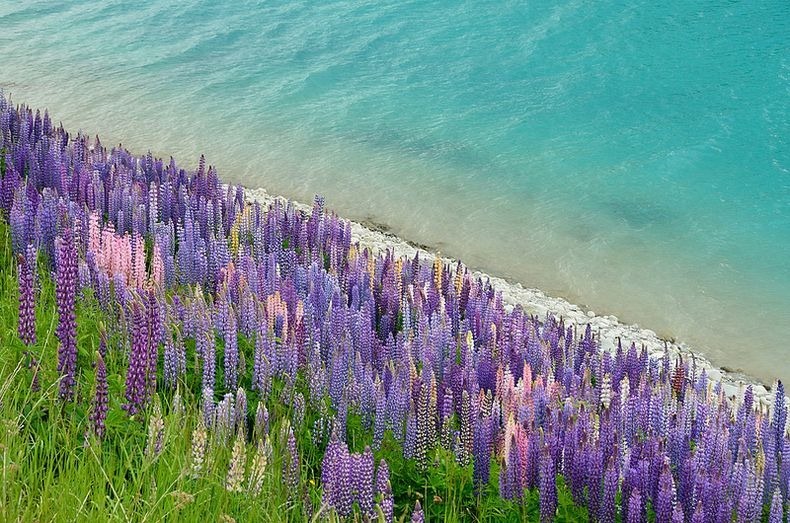Lake Tekapo is the second-largest of three roughly parallel lakes running north–south along the northern edge of the Mackenzie Basin in the South Island of New Zealand. The Lake is a photographer’s dream come true, with snow-topped mountains, turquoise blue lake and a captivating beautiful little church. Every year from mid-November to December, the beauty is enhanced by a colourful display of Lupins.
Russell lupine (Lupinus polyphyllus) is an exotic plant that can grow up to 1.5 metres. It is a perennial species – that is, it flowers and sets seed in the summer, dies back to the stem base over winter, to re-emerge the following summer. Russell lupines produce long, colourful flower heads. The flowers are pea-like and come in a variety of colours - blue, purple, orange, yellow, pink, white or a mixture of two colours. The leaves, divided into green leaflets, are splayed out like fingers on a hand. Stout seedpods are produced that explode in the summer heat, releasing many dark brown seeds.
The Russel Lupins were introduced in the 1950′s by Connie Scott of the nearby high country station of Godley Peaks, when the seed was scattered along the exposed sides of the main highway. These tall spikes of colour now grow in abundance along many roadsides, open areas around the the village, and throughout the scenic Mackenzie country. The variety of colours make the already stunning lake Tekapo area a photographers paradise.
Also see: Moss Pink Blossoms at Hitsujiyama Park, Flower Paradise at Hitachi Seaside Park, and Ashikaga Flower Park

Sources: laketekapo, Wikipedia, Laketekapountouched, Newzealand.com




















Yes. Lovely to look at but there is a significant down side to this prolifically growing introduced plant. Lupins originate from overseas but are crowding out our native plants where ever they take hold. Many of the native plants they displace are not found anywhere else in the world. Furthermore lupins are altering the nature of braided rivers like the Waimakariri. This is because the roots bind the gravels and cause the river to run in deeper channels. The persistence of the lupin enables introduced predators to sneak up on and kill those of our native birds that nest on these braided rivers.
ReplyDeleteWe need to appreciate and enjoy the unique flora and fauna of this country for what it has to offer without needing to irrevocably modify it. I wonder if Connie Scott realises the enormity of her actions in distributing the lupin seeds.
Agreed! Introducing non - native species is almost always a disaster for the native flora and fauna. Even when they're this pretty.
DeleteConnie Scott, my great aunt, died many years ago. She was a farmer's wife in the McKenzie country in the 1950's - I very much doubt anyone would have known how the Lupin would take off then!!
DeleteDo the lupins reduce sand flies? :-)
ReplyDeleteOnly if you use the lupins to beat the sandflies with.
DeleteCan this variety be grown in Ohio by Lake Erie?
ReplyDeleteBeauties can sometimes turn into beasts. They at pretty so sorry they are seeking havoc with your natural floors and rivers
ReplyDelete